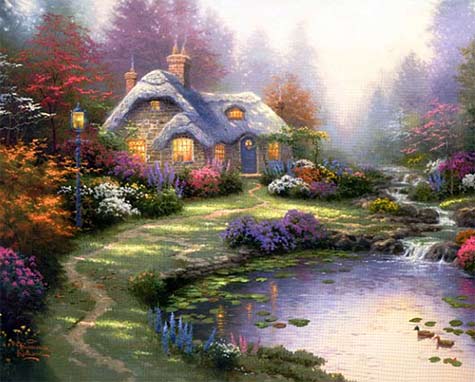On the Death of Thomas Kinkade
On Good Friday, April 7, 2012, the American artist Thomas Kinkade died of natural causes at the age of 54. He was known for his sentimental paintings of tranquil landscapes filled with country cottages, and for renditions of a pastoral Americana that never existed. He marketed himself as the “Painter of Light,” and by the end of his career labeled himself as the most collected living artist in the United States, which was no doubt true.

Kinkade published the first reproductions of his paintings in 1984, an edition of 1,000 that sold for $35 each. By the time of his death his paintings and reproductions were bringing in some $100 million dollars a year, and it has been said that his works have found a place in 10 million American homes.
As any astute observer of cultural matters will tell you, profits and popularity have little to do with quality and profundity, and the works of Kinkade serve as a perfect example of that truism.
In the many art circles I pass through in the city of Los Angeles, Kinkade was always the brunt of jokes, and continually held up as the very antithesis of a serious artist, an opinion undoubtedly held in professional arts circles throughout the nation. However, I will say that I believe Kinkade was sincere in his efforts, unlike so many of the charlatans found in the contemporary art world.
While many of today’s artists are contemptuous of a general public unschooled in the arts, Kinkade embraced that audience; he painted images that millions of people understood and responded to in a deeply personal way. Kinkade’s philosophy was to bring art to everyday people, something every professional artist should be concerned with.
In a brief item I wrote about Kinkade in 2004 titled Shipping Out with Thomas Kinkade, I chided the “painter of light” for producing war propaganda. I vowed it would be “the one and only time you’ll find a painting by Kinkade posted on my web log.” With his passing I am breaking that declaration, and hope this brief article adheres to the tradition of not speaking ill of the dead.
One of the great ironies of Mr. Kinkade’s career was that despite his overwhelming popularity and tremendous financial success, he was shunned by the art establishment. His works are not found in museum collections, to my knowledge he never had a museum show, and it is highly unlikely that any museum anywhere in the world will ever present a retrospective of his paintings. But here is what is so perplexing; while the elite art establishment dismisses Kinkade’s work as so much vapid kitsch, major art museums are exhibiting and acquiring vast collections of vapid kitsch (albeit from artists who self-identify as being kitsch). Such is the state of today’s art world.

